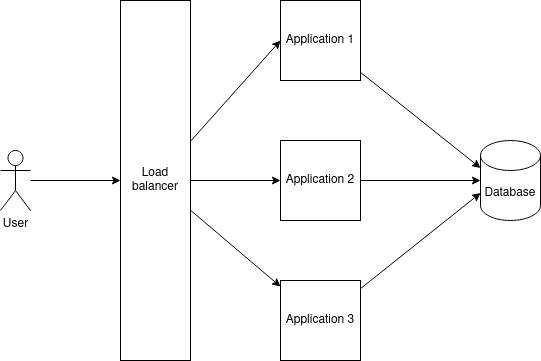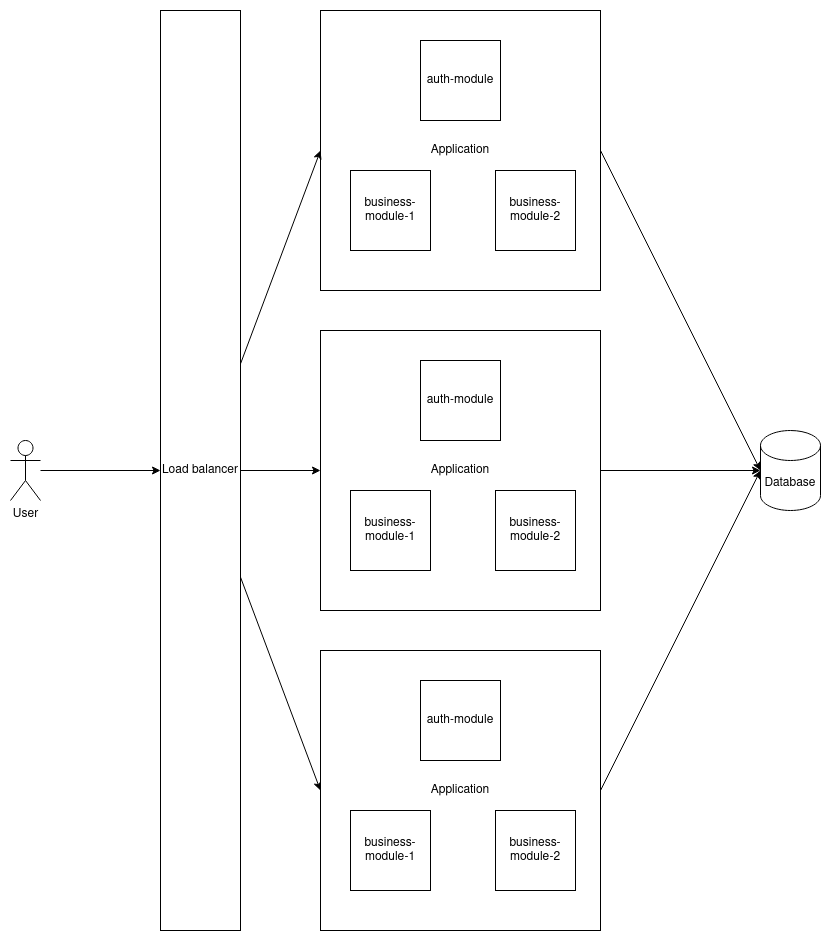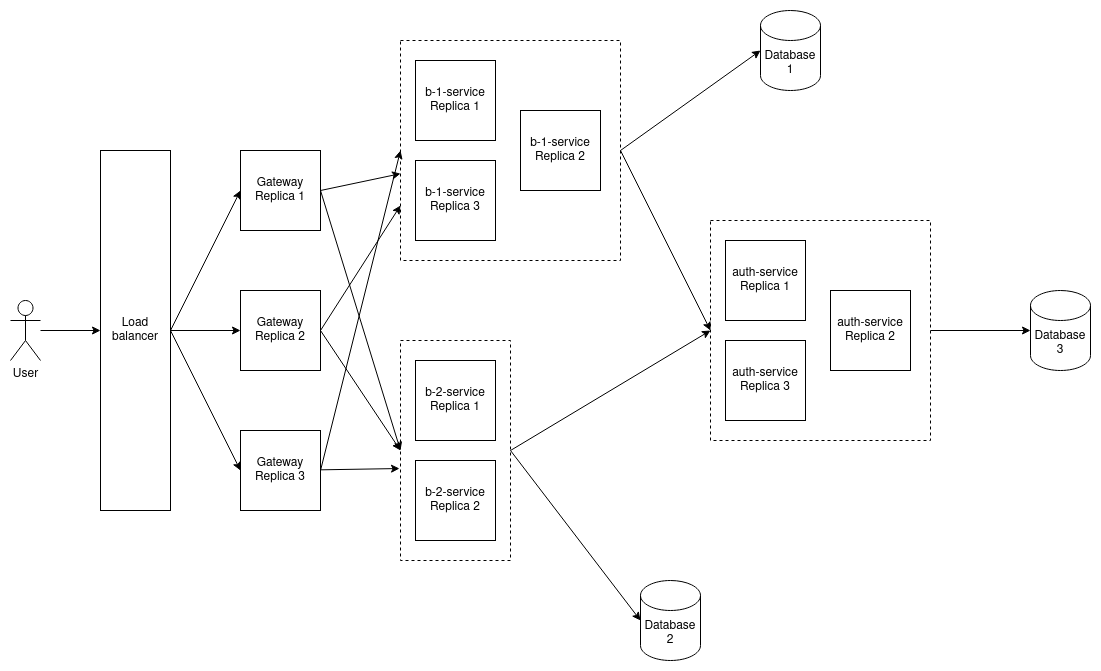Software Architectures Overview
Introduction
During my career I worked on different projects with different architectures. In this post I will describe 3 most important architectures: monolith, modular monolith and microservices.
Monolith
Let’s begin from good old monolith. This is the most simple architecture of application which is usually perceived like something bad by engineers in 2023.
One monolith application

Scaled monoliths

Main idea
All code components exists in one applications, deployed all together.
Use cases
- Small team.
- Need to develop product as fast as possible, for example release full product in 3 days (if you know what I mean :))
- Small budget for a project.
Monolith architecture is an ideal architecture for start ups and small companies with small IT department, because this kind of architecture is the most cheapest architecture.
Pros
- Very fast development:
- Team of developers shouldn’t to communicate with another departments for implement feature or no need to change infrastructure.
- Simple infrastructure:
- No need or minimal DevOps team, dev team can easily adjust simple CI/CD pipelines and deploy monolith to AWS ECS or EC2.
- Simple scaling:
- Very big mistake is to think that monolith can’t be scaled.
- Monolith scales and does it very well, all what need to do is just to develop it it a right way.
- Cheap rent for servers:
- With time servers renting becomes more expensive and this point becomes cons.
Cons
- Complex code base, because all components are highly coupled:
- As far as everything is in one place it’s very common situation when one thing in monolith appplication knows everything about system. This problem can be solved with modular monolith.
- Degrades development speed and servers rent cost with time, because highly coupled components makes system hard to support.
- Changes in one component requires retesting full system:
- This is not always true, but is true in a lot of cases. Modular monolith solves this.
- Usually full regress testing required before release a new version of monolith.
- Hard to scale a team:
- Due to highly coupling of system components work on one monolith from different teams will overlaps, which will results in merge conflicts or so on.
Modular monolith
This is improved monolith version whih solves problems:
- High component coupling.
- Scaling teams.
- Requirement to run full regress testing before release a new version.
One modular monolith application

Scaled modular monoliths

Main idea
Application splited internally on different modules according to module responsibility, for example:
- Auth module - contains code for authorize requests.
- Business logic module 1 - contains code for one of business flows in company.
- Business logic module 2 - contains code for another business flows in company.
This modules communicates which each other throughout in-memory API and them should be implemented as independent applications, but still in one runtime. Also all modules deploys all at once as one application, but maybe implemented possibility to disable module throughout feature flag for emulate microservices behaviour.
Use cases
- Small or medium team. Also it’s a good choice for growing teams.
- Need to have a stable high development speed during some period of time.
- Need to have a possibility for easy migration to microservices architecture.
- Small/medium budget for a project.
Modular monolith architecture is an ideal architecture for growing business, because it provides good scalability for teams and possibility for migration to microservices architecture when business will be ready. Also this architecture provides full cover for non-functional requirements and is not too expensive.
Pros
- Scale team is more easy than with monolith architecture.
- Development speed is high during longer period of time, rather than in monolith architecture.
- Simple infrastructure.
- Simple scaling.
- Cheap servers rent price at start, but with time degrades as in monolith architecture too. Can be solved by possibility for disable/enable modules in application.
- Regress testing no longer required before release every version of software, need test only changed module and it’s dependencies.
Cons
- More complex application design in comparing to monolith architecture.
- Requires more skilled engineers in a team for control development direction, because with bad engineer practics it’s easy to transform modular-monolith to monolith and loose all pros.
- Degradation of development speed and increasing of servers cost is slower in comparing with monolith architecture, but still is present.
Microservices
The most popular architecture in nowadays. I think it happens, because implementing microservices architecture is very complex and interesting task. Also this architecture provides very good benefits as team scaling, simple applications, scalability (but as I told previously scalability can be achieved in another architecture too, so this shouldn’t by main reason for choose microservices architecture).
One microservices system

Scaled microservices system

Main idea
Split system by responsibility and create separate service for it. Communication between microservices executes throughout network. Very important in building microservice architecture is to track dependencies between microservices, otherwise can be created distributed monolith which is the worse mistake in architecture which can be done.
Use cases
- Medium or big teams. Choice for growing from medium to big team.
- Need to have possibility for parallel development.
- Need to have possibility for scale different components of system.
- Big budget for a project.
As for me microservices is a good choice for big companies which have money for big IT department.
Pros
- Easy to scale team:
- Due to different responsibilities in different services parallel development is an easy option.
- Popular architecuture which I suggest decreases complexity for find new developers in the team.
- Every service is simple, thus speed of development for one service is high.
- Easy to scale:
- Possibility to scale each service independently which may reduce costs for servers renting, but the same feature has modular monolith too.
- No need for regress testing in case if dependencies between services are one direction.
- Development speed and scalability don’t degrades with time.
Cons
- Complex infrastructure:
- Dedicated DevOps team should be in company for adjust infrastructure.
- Need to have highly skilled engineers in the team to drive development:
- Microservices architecture is the hardest architecture which seems very simple at first glance. Due to lack of skills in a team there is a big chance to build microservices which depends on each other or with shared databases. Which will results in very hard supported system.
- High cost for support this system, due to requirement to have highly skilled engineers, dedicated DevOps team and servers cost.
- Low development speed in comparing to modular-monolith.
- High requirements for communications between teams.
Conclusions
In this post I described 3 main software architectures in nowadays. I didn’t explained how to choose architecture for a new project, because this post will be overhelmed. I will create a new post with thoughts about choosing an architecture.